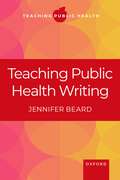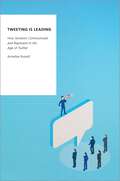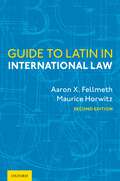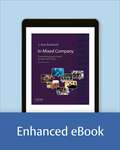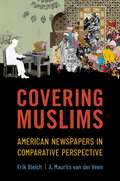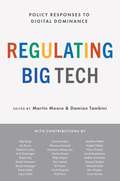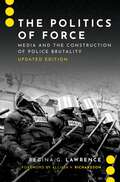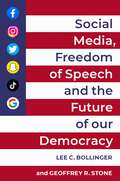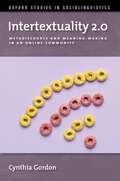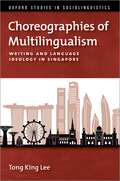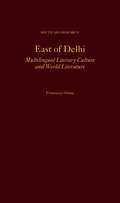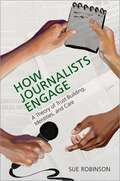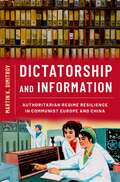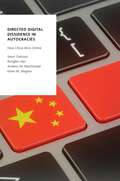- Table View
- List View
Teaching Public Health Writing (Teaching Public Health)
by Jennifer BeardClear, concise, engaging writing is critically important to public health practice. The Covid-19 pandemic has repeatedly thrown this fact into stark relief. No matter how hard we try, with the best intentions and evidence, public health professionals and researchers have struggled to communicate clear messages to the many audiences looking for information. The result has often been resistance, miscommunication, and deepening political division. Teaching Public Health Writing is a call to action for schools and programs of public health. Jennifer Beard, drawing on her interdisciplinary background in population health and the humanities, argues that writing practice and mentoring need to be central components of the graduate and undergraduate public health curriculum. Public health students are learning to translate complex technical content from a wide array of disciplines into engaging documents for vastly different audiences. This learning experience can be time-consuming and anxiety-inducing. Teaching Public Health Writing--the first book in the new Teaching Public Health instructor series--prompts educators at every level to rethink the place of writing in public health education. Using composition and public health theory, narrative examples, and detailed instructions from writing assignments used in public health classrooms across many disciplines and genres, Teaching Public Health Writing offers instructors a helpful guide to refresh or redesign in-course writing instruction and assignments. It ensures the next generation of public health professionals have the tools they need to communicate confidently and effectively.
Teaching Public Health Writing (Teaching Public Health)
by Jennifer BeardClear, concise, engaging writing is critically important to public health practice. The Covid-19 pandemic has repeatedly thrown this fact into stark relief. No matter how hard we try, with the best intentions and evidence, public health professionals and researchers have struggled to communicate clear messages to the many audiences looking for information. The result has often been resistance, miscommunication, and deepening political division. Teaching Public Health Writing is a call to action for schools and programs of public health. Jennifer Beard, drawing on her interdisciplinary background in population health and the humanities, argues that writing practice and mentoring need to be central components of the graduate and undergraduate public health curriculum. Public health students are learning to translate complex technical content from a wide array of disciplines into engaging documents for vastly different audiences. This learning experience can be time-consuming and anxiety-inducing. Teaching Public Health Writing--the first book in the new Teaching Public Health instructor series--prompts educators at every level to rethink the place of writing in public health education. Using composition and public health theory, narrative examples, and detailed instructions from writing assignments used in public health classrooms across many disciplines and genres, Teaching Public Health Writing offers instructors a helpful guide to refresh or redesign in-course writing instruction and assignments. It ensures the next generation of public health professionals have the tools they need to communicate confidently and effectively.
Tweeting is Leading: How Senators Communicate and Represent in the Age of Twitter (Oxford Studies in Digital Politics)
by Annelise RussellSocial media is changing the business of representation in the Senate. If you want to know what your senator is up to, you don't need a newspaper, just your phone. Some senators are social media minimalists while others are digitally long-winded, but each senator has the ability to insert themselves into our daily digital routines and frame their political brand for a public audience. Drawing on a unique dataset of almost 200,000 senator tweets, Tweeting is Leading offers a critical analysis of senators' communication on Twitter, the individual and constituent forces that shape it, and the agendas that result. The public priorities that senators communicate through social media--what Annelise Russell calls their rhetorical agenda--offer a necessary tool for understanding how senators link their carefully crafted public image with potential voters. The rhetorical agenda challenges what we know about representation, removing the institutional and political constraints on congressional communication and giving lawmakers a messaging platform where individual discretion is high, the relative costs are low, and someone is always watching. Tweeting is Leading emphasizes why representation on social media matters for understanding media norms and how lawmakers digitally build a political brand, showing empirically how senators self-constrain their communications to curate different styles of representation that match constituent expectations.
Tweeting is Leading: How Senators Communicate and Represent in the Age of Twitter (Oxford Studies in Digital Politics)
by Annelise RussellSocial media is changing the business of representation in the Senate. If you want to know what your senator is up to, you don't need a newspaper, just your phone. Some senators are social media minimalists while others are digitally long-winded, but each senator has the ability to insert themselves into our daily digital routines and frame their political brand for a public audience. Drawing on a unique dataset of almost 200,000 senator tweets, Tweeting is Leading offers a critical analysis of senators' communication on Twitter, the individual and constituent forces that shape it, and the agendas that result. The public priorities that senators communicate through social media--what Annelise Russell calls their rhetorical agenda--offer a necessary tool for understanding how senators link their carefully crafted public image with potential voters. The rhetorical agenda challenges what we know about representation, removing the institutional and political constraints on congressional communication and giving lawmakers a messaging platform where individual discretion is high, the relative costs are low, and someone is always watching. Tweeting is Leading emphasizes why representation on social media matters for understanding media norms and how lawmakers digitally build a political brand, showing empirically how senators self-constrain their communications to curate different styles of representation that match constituent expectations.
Guide to Latin in International Law
by Aaron X. Fellmeth Maurice HorwitzAs knowledge of Latin continues to diminish, its frequent use in cases, textbooks, treaties, and scholarly works baffles law students, practitioners, and scholars alike. Many of the Latin terms commonly used by international lawyers are not included in some of the more popular law dictionaries. Terms and phrases included in modern dictionaries usually offer nothing more than a literal translation without sufficient explanation or context provided. The Guide to Latin in International Law provides a comprehensive approach and includes both literal translations and definitions with several useful innovations. Included is not only the modern English pronunciation but also the classical or "restored" pronunciation. Its etymology is more complete than the leading law dictionary on the market, and the definition for each term includes examples used in context whenever helpful. Each entry is also cross-referenced to related terms for ease of use. This updated edition is the quintessential desktop reference for understanding Latin terms and phrases across all areas of international law.
In Mixed Company 11e: Communicating in Small Groups and Teams
by J. Dan RothwellIn Mixed Company combines theory, applications, and current research on small group communication in a conversational and engaging style. It is a comprehensive text and has been the market leading small group communication text for the last several editions. The 11th edition will continue to use abundant humor, engaging case studies, novel illustrations, dramatic and poignant examples, personal narratives and vivid stories, and colorful language to encourage students to keep reading. The 11th edition offers an emphasis on meetings with the new Chapter 3, current treatments of COVID and its profound effects on small group dynamics, and comprehensive treatment of virtual groups, in addition to vastly enhanced visual packaging.
Covering Muslims: American Newspapers in Comparative Perspective
by Erik Bleich A. Maurits van der VeenAn examination of how American newspaper articles on Muslims are strikingly negative by any measure. For decades, scholars and observers have criticized negative media portrayals of Muslims and Islam. Yet most of these critiques are limited by their focus on one specific location, a limited time period, or a single outlet. In Covering Muslims, Erik Bleich and A. Maurits van der Veen present the first systematic, large-scale analysis of American newspaper coverage of Muslims through comparisons across groups, time, countries, and topics. The authors demonstrate conclusively that coverage of Muslims is remarkably negative by any measure. They show that American newspapers have been consistently negative across the two-decade period between 1996 and 2016 and that articles on Muslims are more negative than those touching on groups as diverse as Catholics, Jews, Hindus, African Americans, Latinos, Mormons, or atheists. Strikingly, even articles about mundane topics tend to be negative. The authors suggest that media outlets both within and outside the United States may contribute to pervasive Islamophobia and they encourage readers and journalists to "tone check" the media rather than simply accepting negative associations with Muslims or other marginalized groups.
Covering Muslims: American Newspapers in Comparative Perspective
by Erik Bleich A. Maurits van der VeenAn examination of how American newspaper articles on Muslims are strikingly negative by any measure. For decades, scholars and observers have criticized negative media portrayals of Muslims and Islam. Yet most of these critiques are limited by their focus on one specific location, a limited time period, or a single outlet. In Covering Muslims, Erik Bleich and A. Maurits van der Veen present the first systematic, large-scale analysis of American newspaper coverage of Muslims through comparisons across groups, time, countries, and topics. The authors demonstrate conclusively that coverage of Muslims is remarkably negative by any measure. They show that American newspapers have been consistently negative across the two-decade period between 1996 and 2016 and that articles on Muslims are more negative than those touching on groups as diverse as Catholics, Jews, Hindus, African Americans, Latinos, Mormons, or atheists. Strikingly, even articles about mundane topics tend to be negative. The authors suggest that media outlets both within and outside the United States may contribute to pervasive Islamophobia and they encourage readers and journalists to "tone check" the media rather than simply accepting negative associations with Muslims or other marginalized groups.
Regulating Big Tech: Policy Responses to Digital Dominance
by Martin Moore Damian TambiniSelected chapters from this book are published open access and free to read or download from Oxford Scholarship Online, https://oxford.universitypressscholarship.com/. Since Digital Dominance was published in 2018, a global consensus has emerged that technology platforms should be regulated. Governments from the United States to Australia have sought to reduce the power of these platforms and curtail the dominance of a few, yet regulatory responses remain fragmented, with some focused solely on competition while others seek to address issues around harm, privacy, and freedom of expression. Regulating Big Tech condenses the vibrant tech policy debate into a toolkit for the policy maker, legal expert, and academic seeking to address one of the key issues facing democracies today: platform dominance and its impact on society. Contributors explore elements of the toolkit through comprehensive coverage of existing and future policy on data, antitrust, competition, freedom of expression, jurisdiction, fake news, elections, liability, and accountability, while also identifying potential policy impacts on global communication, user rights, public welfare, and economic activity. With original chapters from leading academics and policy experts, Regulating Big Tech sets out a policy framework that can address interlocking challenges of contemporary tech regulation and offer actionable solutions for our technological future.
Regulating Big Tech: Policy Responses to Digital Dominance
by Martin Moore and Damian TambiniSelected chapters from this book are published open access and free to read or download from Oxford Scholarship Online, https://oxford.universitypressscholarship.com/. Since Digital Dominance was published in 2018, a global consensus has emerged that technology platforms should be regulated. Governments from the United States to Australia have sought to reduce the power of these platforms and curtail the dominance of a few, yet regulatory responses remain fragmented, with some focused solely on competition while others seek to address issues around harm, privacy, and freedom of expression. Regulating Big Tech condenses the vibrant tech policy debate into a toolkit for the policy maker, legal expert, and academic seeking to address one of the key issues facing democracies today: platform dominance and its impact on society. Contributors explore elements of the toolkit through comprehensive coverage of existing and future policy on data, antitrust, competition, freedom of expression, jurisdiction, fake news, elections, liability, and accountability, while also identifying potential policy impacts on global communication, user rights, public welfare, and economic activity. With original chapters from leading academics and policy experts, Regulating Big Tech sets out a policy framework that can address interlocking challenges of contemporary tech regulation and offer actionable solutions for our technological future.
The Politics of Force: Media and the Construction of Police Brutality, Updated Edition (JOURNALISM AND POL COMMUN UNBOUND SERIES)
by Regina G. LawrencePublished over twenty years ago, Regina G. Lawrence's The Politics of Force was the first scholarly book to look at the way in which media coverage of unexpected, dramatic events shaped public consciousness about important social and political problems. At a time when police brutality was rarely discussed in the news, Lawrence examined police use of force in over 500 incidents, with an in-depth look at the Rodney King case. In doing so, she showed that when incidents of police brutality became news, they offered one of the few real opportunities for marginalized voices and activists to find a public platform and take on the powerful. In the intervening years, the empirical and theoretical contributions of The Politics of Force have become more significant, not only because police brutality is back in the news, but because the media system itself has changed. In this updated edition, Lawrence contextualizes and extends these contributions, while including a closer look at race and racial justice in incidents of police use of force. Reflecting on the context in which the book was written--a time when race and policing received limited coverage in the news and in the field of political communication--Lawrence considers what has changed in media studies since the year 2000, what things haven't changed, and why. Moreover, Lawrence examines coverage of more recent incidents of police violence and the ways in which the voices of citizen activists are treated in the news today. In turn, she addresses the important question of how defining political problems through such events might or might not produce more lasting policy change. Expanding on her landmark publication, Lawrence provides an accessible update on news production dynamics and police use of force for a new generation of scholars, students, and activists.
The Politics of Force: Media and the Construction of Police Brutality, Updated Edition (JOURNALISM AND POL COMMUN UNBOUND SERIES)
by Regina G. LawrencePublished over twenty years ago, Regina G. Lawrence's The Politics of Force was the first scholarly book to look at the way in which media coverage of unexpected, dramatic events shaped public consciousness about important social and political problems. At a time when police brutality was rarely discussed in the news, Lawrence examined police use of force in over 500 incidents, with an in-depth look at the Rodney King case. In doing so, she showed that when incidents of police brutality became news, they offered one of the few real opportunities for marginalized voices and activists to find a public platform and take on the powerful. In the intervening years, the empirical and theoretical contributions of The Politics of Force have become more significant, not only because police brutality is back in the news, but because the media system itself has changed. In this updated edition, Lawrence contextualizes and extends these contributions, while including a closer look at race and racial justice in incidents of police use of force. Reflecting on the context in which the book was written--a time when race and policing received limited coverage in the news and in the field of political communication--Lawrence considers what has changed in media studies since the year 2000, what things haven't changed, and why. Moreover, Lawrence examines coverage of more recent incidents of police violence and the ways in which the voices of citizen activists are treated in the news today. In turn, she addresses the important question of how defining political problems through such events might or might not produce more lasting policy change. Expanding on her landmark publication, Lawrence provides an accessible update on news production dynamics and police use of force for a new generation of scholars, students, and activists.
Social Media, Freedom of Speech, and the Future of our Democracy
A broad explanation of the various dimensions of the problem of "bad" speech on the internet within the American context. One of the most fiercely debated issues of this era is what to do about "bad" speech-hate speech, disinformation and propaganda campaigns, and incitement of violence-on the internet, and in particular speech on social media platforms such as Facebook and Twitter. In Social Media, Freedom of Speech, and the Future of our Democracy, Lee C. Bollinger and Geoffrey R. Stone have gathered an eminent cast of contributors--including Hillary Clinton, Amy Klobuchar, Sheldon Whitehouse, Newt Minow, Cass Sunstein, Jack Balkin, Emily Bazelon, and others--to explore the various dimensions of this problem in the American context. They stress how difficult it is to develop remedies given that some of these forms of "bad" speech are ordinarily protected by the First Amendment. Bollinger and Stone argue that it is important to remember that the last time we encountered major new communications technology-television and radio-we established a federal agency to provide oversight and to issue regulations to protect and promote "the public interest." Featuring a variety of perspectives from some of America's leading experts on this hotly contested issue, this volume offers new insights for the future of free speech in the social media era.
Social Media, Freedom of Speech, and the Future of our Democracy
by Lee C. Bollinger, Geoffrey R. StoneA broad explanation of the various dimensions of the problem of "bad" speech on the internet within the American context. One of the most fiercely debated issues of this era is what to do about "bad" speech-hate speech, disinformation and propaganda campaigns, and incitement of violence-on the internet, and in particular speech on social media platforms such as Facebook and Twitter. In Social Media, Freedom of Speech, and the Future of our Democracy, Lee C. Bollinger and Geoffrey R. Stone have gathered an eminent cast of contributors--including Hillary Clinton, Amy Klobuchar, Sheldon Whitehouse, Newt Minow, Cass Sunstein, Jack Balkin, Emily Bazelon, and others--to explore the various dimensions of this problem in the American context. They stress how difficult it is to develop remedies given that some of these forms of "bad" speech are ordinarily protected by the First Amendment. Bollinger and Stone argue that it is important to remember that the last time we encountered major new communications technology-television and radio-we established a federal agency to provide oversight and to issue regulations to protect and promote "the public interest." Featuring a variety of perspectives from some of America's leading experts on this hotly contested issue, this volume offers new insights for the future of free speech in the social media era.
Intertextuality 2.0: Metadiscourse and Meaning-Making in an Online Community (OXFORD STUDIES SOCIOLINGUISTICS SERIES)
by Cynthia Gordon"Intertextuality" is the overarching idea that all texts and conversations are linked to other texts and conversations, and that people create and infer meanings in discourse through making and interpreting these links. Intertextuality is fundamentally connected to metadiscourse; when a person draws on or references one text or conversation in another (intertextuality), they necessarily communicate something about that text or conversation (metadiscourse). While scholars have long recognized the interrelatedness of these two theoretical concepts, existing studies have tended to focus on one or the other, leaving underexplored the specific ways in which these phenomena are intertwined at the micro-interactional level, especially online, and for what purposes. This interactional sociolinguistic study contributes to filling this gap by demonstrating how specific intertextual linking strategies, both linguistic (e.g., word repetition, deictic pronouns) and multimodal (e.g., emojis, symbols, and GIFs), are mobilized by posters participating in online weight loss discussion boards. These strategies serve as a resource to accomplish the metadiscursive activities, targeted at various levels of discourse, through which participants construct shared understandings, negotiate the group's interactional norms, and facilitate engagement in the group's primary shared activity: exchanging information about, and providing support for, weight loss, healthful eating, and related issues. By rigorously applying the perspective of metadiscourse in a study of intertextuality, Intertextuality 2.0 offers important new insights into why intertextuality occurs and what it accomplishes: it helps people manage the challenges of communication.
Intertextuality 2.0: Metadiscourse and Meaning-Making in an Online Community (OXFORD STUDIES SOCIOLINGUISTICS SERIES)
by Cynthia Gordon"Intertextuality" is the overarching idea that all texts and conversations are linked to other texts and conversations, and that people create and infer meanings in discourse through making and interpreting these links. Intertextuality is fundamentally connected to metadiscourse; when a person draws on or references one text or conversation in another (intertextuality), they necessarily communicate something about that text or conversation (metadiscourse). While scholars have long recognized the interrelatedness of these two theoretical concepts, existing studies have tended to focus on one or the other, leaving underexplored the specific ways in which these phenomena are intertwined at the micro-interactional level, especially online, and for what purposes. This interactional sociolinguistic study contributes to filling this gap by demonstrating how specific intertextual linking strategies, both linguistic (e.g., word repetition, deictic pronouns) and multimodal (e.g., emojis, symbols, and GIFs), are mobilized by posters participating in online weight loss discussion boards. These strategies serve as a resource to accomplish the metadiscursive activities, targeted at various levels of discourse, through which participants construct shared understandings, negotiate the group's interactional norms, and facilitate engagement in the group's primary shared activity: exchanging information about, and providing support for, weight loss, healthful eating, and related issues. By rigorously applying the perspective of metadiscourse in a study of intertextuality, Intertextuality 2.0 offers important new insights into why intertextuality occurs and what it accomplishes: it helps people manage the challenges of communication.
Choreographies of Multilingualism: Writing and Language Ideology in Singapore (OXFORD STUDIES SOCIOLINGUISTICS SERIES)
by Tong King LeeSingapore boasts a complex mix of languages and is therefore a rich site for the study of multilingualism and multilingual society. In particular, writing is a key medium in the production of the nation's multilingual order - one that is often used to organize language relations for public consumption. In Choreographies of Multilingualism, Tong King Lee examines the linguistic landscape of written language in Singapore - from street signage and advertisements, to institutional anthologies and text-based memorabilia, to language primers and social media-based poetry - to reveal the underpinning language ideologies and how those ideologies figure in political tensions. The book analyzes the competing official and grassroots narratives around multilingualism and takes a nuanced approach to discuss the marginalization, celebration, or appropriation of Singlish. Bringing together theoretical perspectives from sociolinguistics, multimodal semiotics, translation, and cultural studies, Lee demonstrates that multilingualism in Singapore is an emergent and evolving construct through which identities and ideologies are negotiated and articulated. Broad-ranging and cross-disciplinary, this book offers a significant contribution to our understanding of language in Singapore, and more broadly to our understanding of multilingualism and the sociolinguistics of writing.
Choreographies of Multilingualism: Writing and Language Ideology in Singapore (OXFORD STUDIES SOCIOLINGUISTICS SERIES)
by Tong King LeeSingapore boasts a complex mix of languages and is therefore a rich site for the study of multilingualism and multilingual society. In particular, writing is a key medium in the production of the nation's multilingual order - one that is often used to organize language relations for public consumption. In Choreographies of Multilingualism, Tong King Lee examines the linguistic landscape of written language in Singapore - from street signage and advertisements, to institutional anthologies and text-based memorabilia, to language primers and social media-based poetry - to reveal the underpinning language ideologies and how those ideologies figure in political tensions. The book analyzes the competing official and grassroots narratives around multilingualism and takes a nuanced approach to discuss the marginalization, celebration, or appropriation of Singlish. Bringing together theoretical perspectives from sociolinguistics, multimodal semiotics, translation, and cultural studies, Lee demonstrates that multilingualism in Singapore is an emergent and evolving construct through which identities and ideologies are negotiated and articulated. Broad-ranging and cross-disciplinary, this book offers a significant contribution to our understanding of language in Singapore, and more broadly to our understanding of multilingualism and the sociolinguistics of writing.
East of Delhi: Multilingual Literary Culture and World Literature (South Asia Research)
by Francesca OrsiniLike many societies across the world, the region of Awadh in North India has been bilingual throughout its history. But literary histories of the region often indicate otherwise. In the early twentieth century, colonists recodified literary histories separately according to language, detached written literature from oral literature, and reimagined the entangled literary past according to their own ideas about language, literature, and Indian history. At the same time, multilingualism remained resilient and acquired new uses. East of Delhi: Multilingual Literary Culture and World Literature examines literature produced, practiced, and circulated in and out of North India, focusing on the region of Awadh, from the beginning of recorded vernacular literature in the late fourteenth century to the colonial era of the early twentieth century. This book considers texts in a wide range of genres-courtly, devotional, and popular-composed in the main languages of the region: Hindavi, Persian, Brajbhasha, Urdu. Individual chapters focus on narratives, devotional song-poems and didactic works, local courtly literary practices, and multilingual education as recorded in biographical dictionaries-anthologies. Author Francesca Orsini suggests that this multilingual and multi-genre approach is better suited to capturing the texture, complexity, and dynamics of literature in the world, and of literary history, than approaches that focus only on global circulation or models that draw centers and peripheries on a single global map.
East of Delhi: Multilingual Literary Culture and World Literature (South Asia Research)
by Francesca OrsiniLike many societies across the world, the region of Awadh in North India has been bilingual throughout its history. But literary histories of the region often indicate otherwise. In the early twentieth century, colonists recodified literary histories separately according to language, detached written literature from oral literature, and reimagined the entangled literary past according to their own ideas about language, literature, and Indian history. At the same time, multilingualism remained resilient and acquired new uses. East of Delhi: Multilingual Literary Culture and World Literature examines literature produced, practiced, and circulated in and out of North India, focusing on the region of Awadh, from the beginning of recorded vernacular literature in the late fourteenth century to the colonial era of the early twentieth century. This book considers texts in a wide range of genres-courtly, devotional, and popular-composed in the main languages of the region: Hindavi, Persian, Brajbhasha, Urdu. Individual chapters focus on narratives, devotional song-poems and didactic works, local courtly literary practices, and multilingual education as recorded in biographical dictionaries-anthologies. Author Francesca Orsini suggests that this multilingual and multi-genre approach is better suited to capturing the texture, complexity, and dynamics of literature in the world, and of literary history, than approaches that focus only on global circulation or models that draw centers and peripheries on a single global map.
How Journalists Engage: A Theory of Trust Building, Identities, and Care
by Sue RobinsonA unique theory of trust building in engagement journalism that proposes journalists move to an ethic of care as they prioritize listening and learning within communities instead of propping up problematic institutions. In How Journalists Engage, Sue Robinson explores how journalists of different identities, especially racial, enact trusting relationships with their audiences. Drawing from case studies, community-work, interviews, and focus groups, she documents a growing built environment around trust building and engagement journalism that represents the first major paradigm shift of the press's core values in more than a century. As Robinson shows, journalists are being trained to take on new roles and skillsets around listening and learning, in addition to normative routines related to being a watchdog and storyteller. She demonstrates how this movement mobilizes the nurturing of personal, organizational, and institutional relationships that people have with information, sources, news brands, journalists, and each other. Developing a new theory of trust building, Robinson calls for journalists to grapple actively with their own identities--especially the privileges, biases, and marginalization attached to them--and those of their communities, resulting in a more intentional and effective moral voice focused on justice and equity through the news practice of an ethic of care.
How Journalists Engage: A Theory of Trust Building, Identities, and Care
by Sue RobinsonA unique theory of trust building in engagement journalism that proposes journalists move to an ethic of care as they prioritize listening and learning within communities instead of propping up problematic institutions. In How Journalists Engage, Sue Robinson explores how journalists of different identities, especially racial, enact trusting relationships with their audiences. Drawing from case studies, community-work, interviews, and focus groups, she documents a growing built environment around trust building and engagement journalism that represents the first major paradigm shift of the press's core values in more than a century. As Robinson shows, journalists are being trained to take on new roles and skillsets around listening and learning, in addition to normative routines related to being a watchdog and storyteller. She demonstrates how this movement mobilizes the nurturing of personal, organizational, and institutional relationships that people have with information, sources, news brands, journalists, and each other. Developing a new theory of trust building, Robinson calls for journalists to grapple actively with their own identities--especially the privileges, biases, and marginalization attached to them--and those of their communities, resulting in a more intentional and effective moral voice focused on justice and equity through the news practice of an ethic of care.
Dictatorship and Information: Authoritarian Regime Resilience in Communist Europe and China
by Martin K. DimitrovFear pervades dictatorial regimes. Citizens fear leaders, the regime's agents fear superiors, and leaders fear the masses. The ubiquity of fear in such regimes gives rise to the "dictator's dilemma," where autocrats do not know the level of opposition they face and cannot effectively neutralize domestic threats to their rule. The dilemma has led scholars to believe that autocracies are likely to be short-lived. Yet, some autocracies have found ways to mitigate the dictator's dilemma. As Martin K. Dimitrov shows in Dictatorship and Information, substantial variability exists in the survival of nondemocratic regimes, with single-party polities having the longest average duration. Offering a systematic theory of the institutional solutions to the dictator's dilemma, Dimitrov argues that single-party autocracies have fostered channels that allow for the confidential vertical transmission of information, while also solving the problems associated with distorted information. To explain how this all works, Dimitrov focuses on communist regimes, which have the longest average lifespan among single-party autocracies and have developed the most sophisticated information-gathering institutions. Communist regimes face a variety of threats, but the main one is the masses. Dimitrov therefore examines the origins, evolution, and internal logic of the information-collection ecosystem established by communist states to monitor popular dissent. Drawing from a rich base of evidence across multiple communist regimes and nearly 100 interviews, Dimitrov reshapes our understanding of how autocrats learn--or fail to learn--about the societies they rule, and how they maintain--or lose--power.
Dictatorship and Information: Authoritarian Regime Resilience in Communist Europe and China
by Martin K. DimitrovFear pervades dictatorial regimes. Citizens fear leaders, the regime's agents fear superiors, and leaders fear the masses. The ubiquity of fear in such regimes gives rise to the "dictator's dilemma," where autocrats do not know the level of opposition they face and cannot effectively neutralize domestic threats to their rule. The dilemma has led scholars to believe that autocracies are likely to be short-lived. Yet, some autocracies have found ways to mitigate the dictator's dilemma. As Martin K. Dimitrov shows in Dictatorship and Information, substantial variability exists in the survival of nondemocratic regimes, with single-party polities having the longest average duration. Offering a systematic theory of the institutional solutions to the dictator's dilemma, Dimitrov argues that single-party autocracies have fostered channels that allow for the confidential vertical transmission of information, while also solving the problems associated with distorted information. To explain how this all works, Dimitrov focuses on communist regimes, which have the longest average lifespan among single-party autocracies and have developed the most sophisticated information-gathering institutions. Communist regimes face a variety of threats, but the main one is the masses. Dimitrov therefore examines the origins, evolution, and internal logic of the information-collection ecosystem established by communist states to monitor popular dissent. Drawing from a rich base of evidence across multiple communist regimes and nearly 100 interviews, Dimitrov reshapes our understanding of how autocrats learn--or fail to learn--about the societies they rule, and how they maintain--or lose--power.
Directed Digital Dissidence in Autocracies: How China Wins Online (Oxford Studies in Digital Politics)
by Jason Gainous Rongbin Han Andrew W. MacDonald Kevin M. WagnerDoes the Internet fundamentally change the flow of politically relevant information, even in authoritarian regimes? If so, does it alter the attitudes and behavior of citizens? While there is a fair amount of research exploring how social media has empowered social actors to challenge authoritarian regimes, there is much less addressing whether and how the state can actively shape the flow of information to its advantage. In China, for instance, citizens often resort to "rightful resistance" to lodge complaints and defend rights. By using the rhetoric of the central government, powerless citizens may exploit the slim political opportunity structure and negotiate with the state for better governance. But this tactic also reinforces the legitimacy of authoritarian states; citizens engage rightful resistance precisely because they trust the state, at least the central government, to some degree. Drawing on original survey data and rich qualitative sources, Directed Digital Dissidence in Autocracies explores how authoritarian regimes employ the Internet in advantageous ways to direct the flow of online information. The authors argue that the central Chinese government successfully directs citizen dissent toward local government through critical information that the central government places online--a strategy that the authors call "directed digital dissidence". In this context, citizens engage in low-level protest toward the local government, and thereby feel empowered, while the central government avoids overthrow. Consequently, the Internet functions to discipline local state agents and to project a benevolent image of the central government and the regime as a whole. With an in-depth look at the COVID-19 and Xinjiang Cotton cases, the authors demonstrate how the Chinese state employs directed digital dissidence and discuss the impact and limitations of China's information strategy.
